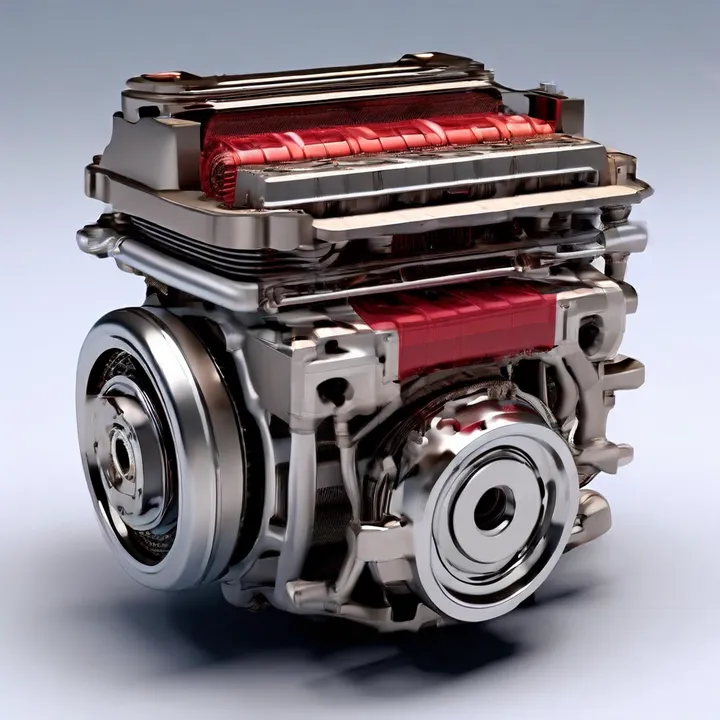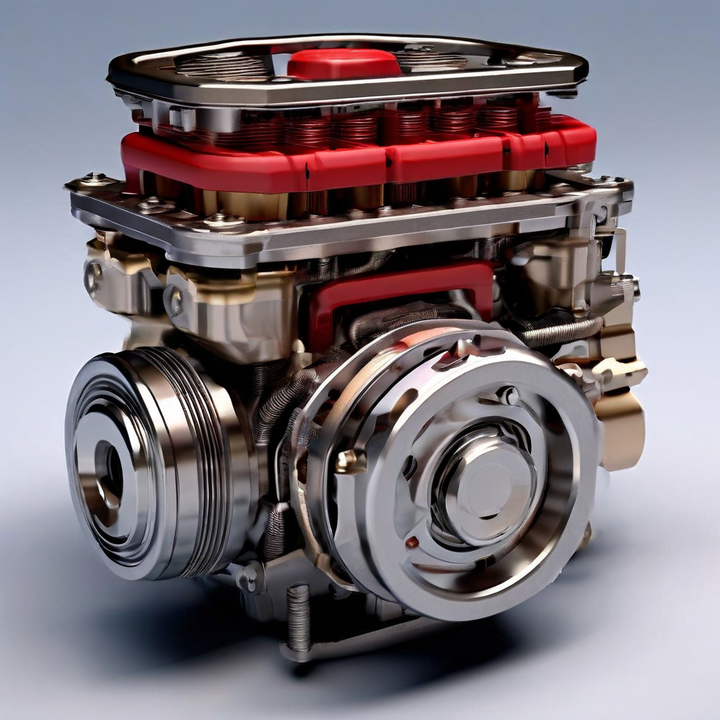


The diagnostic trouble code (DTC) P03AE indicates that the engine control module (ECM) has detected low pressure in cylinder 3 of the engine. This code is specific to engines with cylinder deactivation technology, where some cylinders can be deactivated under certain driving conditions to improve fuel efficiency.
Before we delve into the diagnostic and repair process, let's explore the common culprits behind the P03AE code. These are the usual suspects:
| Cause | Description |
|---|---|
| Faulty Pressure Sensor | The pressure sensor itself could be defective, damaged, or have a wiring issue, causing incorrect pressure readings. |
| Low Compression in Cylinder 3 | Worn piston rings, leaking valves, or other mechanical issues can lead to low compression, resulting in low cylinder pressure. |
| Fuel Delivery Issues | A clogged or faulty fuel injector for cylinder 3 can restrict fuel delivery, leading to incomplete combustion and low pressure. |
| Ignition System Faults | Problems with the spark plug, coil pack, or associated wiring for cylinder 3 can cause misfires and low cylinder pressure. |
Let's start with the pressure sensor itself. These little guys are responsible for monitoring the pressure levels in each cylinder, and if one goes rogue, it can trigger the dreaded P03AE code. A defective sensor, damaged wiring, or loose connections can all lead to incorrect pressure readings, setting off the warning light on your dashboard.
Common signs of a faulty pressure sensor:
Erratic or fluctuating pressure readings
Intermittent P03AE code
Visible damage or corrosion on the sensor or wiring
Now, this one's a bit more serious. Low compression in cylinder 3 can be caused by worn piston rings, leaking valves, or other mechanical issues. When compression is low, the engine struggles to build up the necessary pressure for efficient combustion, resulting in that pesky P03AE code.
Potential causes of low compression:
Worn piston rings
Leaking valves
Damaged cylinder walls
Blown head gasket
Imagine trying to start a campfire with a clogged fuel injector – it's not going to be a pretty sight. The same principle applies to your engine's cylinder 3. If the fuel injector responsible for delivering fuel to that cylinder is clogged or faulty, you'll end up with incomplete combustion and, you guessed it, low cylinder pressure.
Signs of fuel delivery issues:
Rough idling or misfiring
Decreased fuel economy
Visible buildup or damage on the fuel injector
Last but not least, we have the ignition system. If the spark plug, coil pack, or associated wiring for cylinder 3 is acting up, it can cause misfires and, consequently, low cylinder pressure. It's like trying to light a match in a hurricane – not exactly ideal conditions for combustion.
Common ignition system issues:
Fouled or worn spark plugs
Faulty coil pack or wiring
Misfiring or rough running engine
Now that we've covered the potential causes, it's time to roll up our sleeves and get to the bottom of this P03AE mystery. Here's how we do it:
First things first, we'll give your engine a good once-over. We'll check for any obvious signs of damage or wear on components related to cylinder 3, such as the spark plug, injector, and associated wiring. If something looks out of place or suspicious, we'll make a note of it.
Inspection checklist:
Spark plug condition
Fuel injector condition
Wiring harness condition
Visible leaks or damage
Next up, we'll perform a compression test on cylinder 3. This will help us determine if low compression is the culprit behind the P03AE code. If the compression is low, we'll know we're dealing with worn piston rings, leaking valves, or other mechanical issues.
Compression test procedure:
Warm up the engine to operating temperature
Remove the spark plug from cylinder 3
Insert the compression tester
Crank the engine and record the compression reading
Compare the reading to the manufacturer's specifications
We can't forget about the fuel system, can we? We'll check the fuel pressure and inspect the fuel injector for cylinder 3 to ensure proper fuel delivery. A clogged or faulty injector could be the root of our problems.
Fuel system test procedures:
Fuel pressure test
Fuel injector flow test
Visual inspection of the fuel injector
Last but not least, we'll take a closer look at the ignition system for cylinder 3. We'll check the spark plug, coil pack, and associated wiring to make sure everything is firing on all cylinders (pun intended).
Ignition system test procedures:
Spark plug inspection
Coil pack resistance test
Wiring continuity test
Throughout this process, we'll be relying on our trusty scan tool to read live data and freeze frame data related to the P03AE code. This little gadget can provide valuable insights and help us pinpoint the specific issue with greater accuracy.
Scan tool data analysis:
Live data monitoring
Freeze frame data review
Cylinder-specific misfire detection
Once we've identified the root cause of the P03AE code, it's time to roll up our sleeves and get to work. Here are some common repair procedures and preventive measures:
If the pressure sensor for cylinder 3 is the culprit, we'll replace it with a shiny new one. We'll follow the manufacturer's instructions to the letter, ensuring proper wiring connections and routing. It's like giving your engine a fresh set of eyes to monitor cylinder pressure.
Pressure sensor replacement procedure:
Disconnect the battery
Remove the old pressure sensor
Install the new pressure sensor
Reconnect the wiring harness
Reconnect the battery and clear the trouble code
If low compression is the issue, we'll need to dig a little deeper. Depending on the root cause, we may need to replace worn piston rings, repair leaking valves, or even overhaul the entire cylinder head. It's a bit more involved, but trust me, it's worth it to get your engine running like a well-oiled machine again.
Potential repairs for low compression:
Piston ring replacement
Valve repair or replacement
Cylinder head overhaul
If the fuel injector for cylinder 3 is clogged or faulty, we'll swap it out for a brand-new one. This will ensure proper fuel delivery and help restore the balance of combustion in your engine.
Fuel injector replacement procedure:
Depressurize the fuel system
Disconnect the fuel injector wiring
Remove the old fuel injector
Install the new fuel injector
Reconnect the wiring and pressurize the system
If the ignition system is the culprit, we'll replace the spark plug, coil pack, or associated wiring for cylinder 3, as needed. A properly functioning ignition system is crucial for efficient combustion and preventing misfires.
Ignition system repair procedures:
Spark plug replacement
Coil pack replacement
Wiring harness repair or replacement
Of course, prevention is always better than cure. To avoid future issues, we'll recommend following the manufacturer's recommended maintenance schedule for your vehicle. Regular engine oil changes, air filter replacements, and spark plug replacements can go a long way in keeping your engine running smoothly.
Preventive maintenance checklist:
Regular engine oil changes
Air filter replacements
Spark plug replacements
Fuel system cleanings
We'll also advise against excessive idling, aggressive driving, or other conditions that can lead to incomplete combustion or excessive wear on engine components. And, of course, using high-quality fuel from reputable sources is a must to prevent contamination or buildup that could clog fuel injectors or damage engine components.
Proper operation guidelines:
Avoid excessive idling
Avoid aggressive driving
Use high-quality fuel
Now, let's address the elephant in the room – the cost of repairs. The truth is, the cost can vary depending on the specific cause of the P03AE code and the make and model of your vehicle. However, here are some general cost estimates to give you an idea:
| Repair | Estimated Cost |
|---|---|
| Replacing a cylinder pressure sensor | $100 - $300 |
| Replacing a fuel injector | $200 - $500 |
| Replacing a spark plug or coil pack | $50 - $200 |
| Addressing low compression issues (e.g., piston rings, valves) | $1,000 - $3,000 or more |
I know, those numbers can be a bit daunting, but trust me, it's better to address the issue promptly than to let it linger. Ignoring the P03AE code can lead to further damage and even more expensive repairs down the line.
Dealing with the P03AE code can be a bit of a headache, but with the right knowledge and expertise, it's a challenge we can tackle head-on. Remember, having a professional mechanic diagnose the issue accurately is crucial to avoid unnecessary repairs and associated costs.
So, fellow gearheads, don't let that pesky P03AE code get you down. With a little elbow grease, some diagnostic wizardry, and a healthy dose of preventive maintenance, we can keep your engine running like a well-oiled machine for years to come.
Happy wrenching!
The P03AE code indicates that the pressure in cylinder 3 of the engine is too low. This can be caused by various issues affecting the combustion process in that specific cylinder.
Common causes include a faulty cylinder 3 pressure sensor, low compression in cylinder 3 due to worn piston rings or leaking valves, fuel delivery issues to cylinder 3, or ignition system faults related to cylinder 3.
Initially, the P03AE code may not be a serious issue, but it should be addressed promptly to prevent further damage and more expensive repairs down the line.
While you can continue driving for a short period, it is recommended to have the issue diagnosed and repaired as soon as possible to avoid potential engine damage.
Diagnosis typically involves visual inspections, compression tests, fuel system tests, ignition system tests, and using a professional-grade scan tool to analyze live data and freeze frame data related to the code.
Common repairs include replacing the cylinder 3 pressure sensor, addressing low compression issues (e.g., piston rings, valves), replacing the fuel injector for cylinder 3, or addressing ignition system faults (e.g., spark plug, coil pack, wiring).
Regular maintenance, proper operation (avoiding excessive idling or aggressive driving), and using high-quality fuel can help prevent recurrence of the P03AE code.
The cost can vary widely depending on the specific cause, but estimates range from $100-$500 for sensor or component replacements to $1,000-$3,000 or more for addressing low compression issues.
While some repairs, such as replacing sensors or spark plugs, may be possible for experienced DIYers, it is generally recommended to have a professional mechanic diagnose and repair issues related to the P03AE code to ensure proper diagnosis and avoid further damage.
No, the P03AE code is a generic OBD-II trouble code that can occur in various vehicle makes and models, as it relates to a specific cylinder's pressure being too low.

Miguel started tinkering with car radios as a teenager, fascinated by the intricate dance of wires and circuits. This passion led him to pursue a career as an automotive electrician. For the past 10 years, Miguel has tackled everything from flickering headlights to mysterious electrical gremlins. He thrives on troubleshooting electrical problems and enjoys sharing his knowledge to empower car owners to understand their vehicles better.



